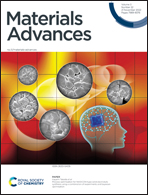Vapor-phase hydrothermal construction of defective MoS2 for highly selective electrocatalytic hydrogenation of cinnamaldehyde†
Abstract
Electrocatalytic selective hydrogenation of α,β-unsaturated aldehydes with water as the hydrogen donor is of great significance to produce fine chemicals. Here, we propose a facile vapor-phase hydrothermal (VPH) method to directly grow defective MoS2 nanoparticles on commercial carbon fiber cloth (MoS2/CFC) for electrocatalytic selective hydrogenation of cinnamaldehyde (CAL). The as-prepared MoS2/CFC exhibited the highest CAL conversion of 88.8% with a maximum TOF value of 12.8 mmol mmolMoS2−1 h−1 at −0.7 V vs. RHE. The high selectivity of CAL hydrogenation could be realized by adjusting the applied potentials, C![[double bond, length as m-dash]](https://www.rsc.org/images/entities/char_e001.gif) O hydrogenation product cinnamyl alcohol (COL) was easier to form under lower applied potentials, whereas C
O hydrogenation product cinnamyl alcohol (COL) was easier to form under lower applied potentials, whereas C![[double bond, length as m-dash]](https://www.rsc.org/images/entities/char_e001.gif) C hydrogenation product hydrocinnamaldehyde (HCAL) was easier to achieve under higher applied potentials. Density functional theory (DFT) calculation findings demonstrated that the Mo vacancies in the defective MoS2/CFC facilitated the adsorption of hydrogen atoms, which benefited the generation of Hads and the proceeding of electrocatalytic hydrogenation. Additionally, the existence of Mo vacancies made the C
C hydrogenation product hydrocinnamaldehyde (HCAL) was easier to achieve under higher applied potentials. Density functional theory (DFT) calculation findings demonstrated that the Mo vacancies in the defective MoS2/CFC facilitated the adsorption of hydrogen atoms, which benefited the generation of Hads and the proceeding of electrocatalytic hydrogenation. Additionally, the existence of Mo vacancies made the C![[double bond, length as m-dash]](https://www.rsc.org/images/entities/char_e001.gif) O group more active than the C
O group more active than the C![[double bond, length as m-dash]](https://www.rsc.org/images/entities/char_e001.gif) C group, and reduced the reaction energy of CAL hydrogenation toward COL. Combined with the experimental results and calculation data, we speculate that the real catalytic active center of the defective MoS2/CFC is the defective configuration of Mo vacancies. Furthermore, the high conversion and selectivity of furfural and benzaldehyde hydrogenation confirmed the universality of the defective MoS2/CFC catalyst in electrocatalytic hydrogenation reduction of unsaturated and saturated aldehydes.
C group, and reduced the reaction energy of CAL hydrogenation toward COL. Combined with the experimental results and calculation data, we speculate that the real catalytic active center of the defective MoS2/CFC is the defective configuration of Mo vacancies. Furthermore, the high conversion and selectivity of furfural and benzaldehyde hydrogenation confirmed the universality of the defective MoS2/CFC catalyst in electrocatalytic hydrogenation reduction of unsaturated and saturated aldehydes.



 Please wait while we load your content...
Please wait while we load your content...